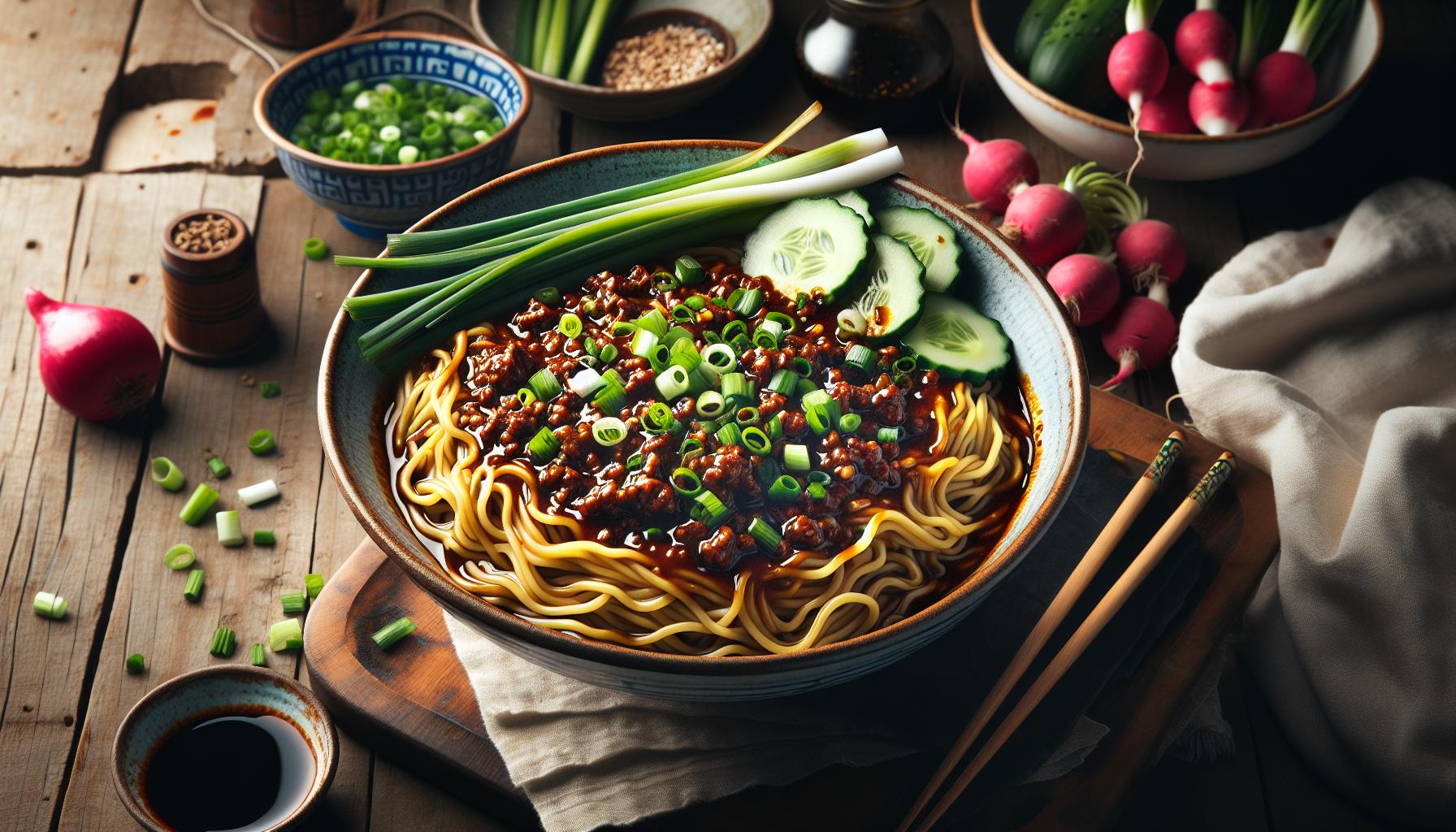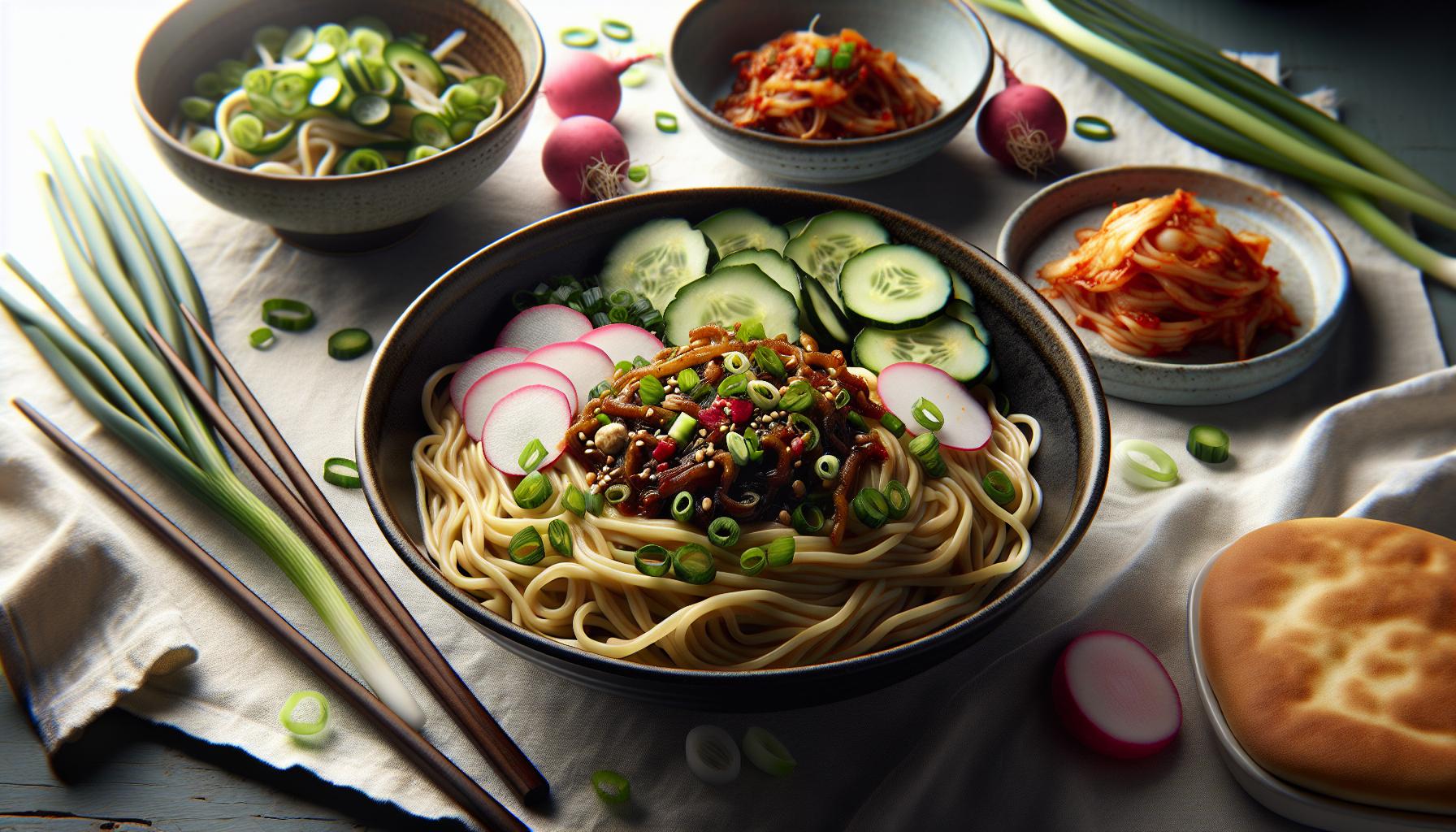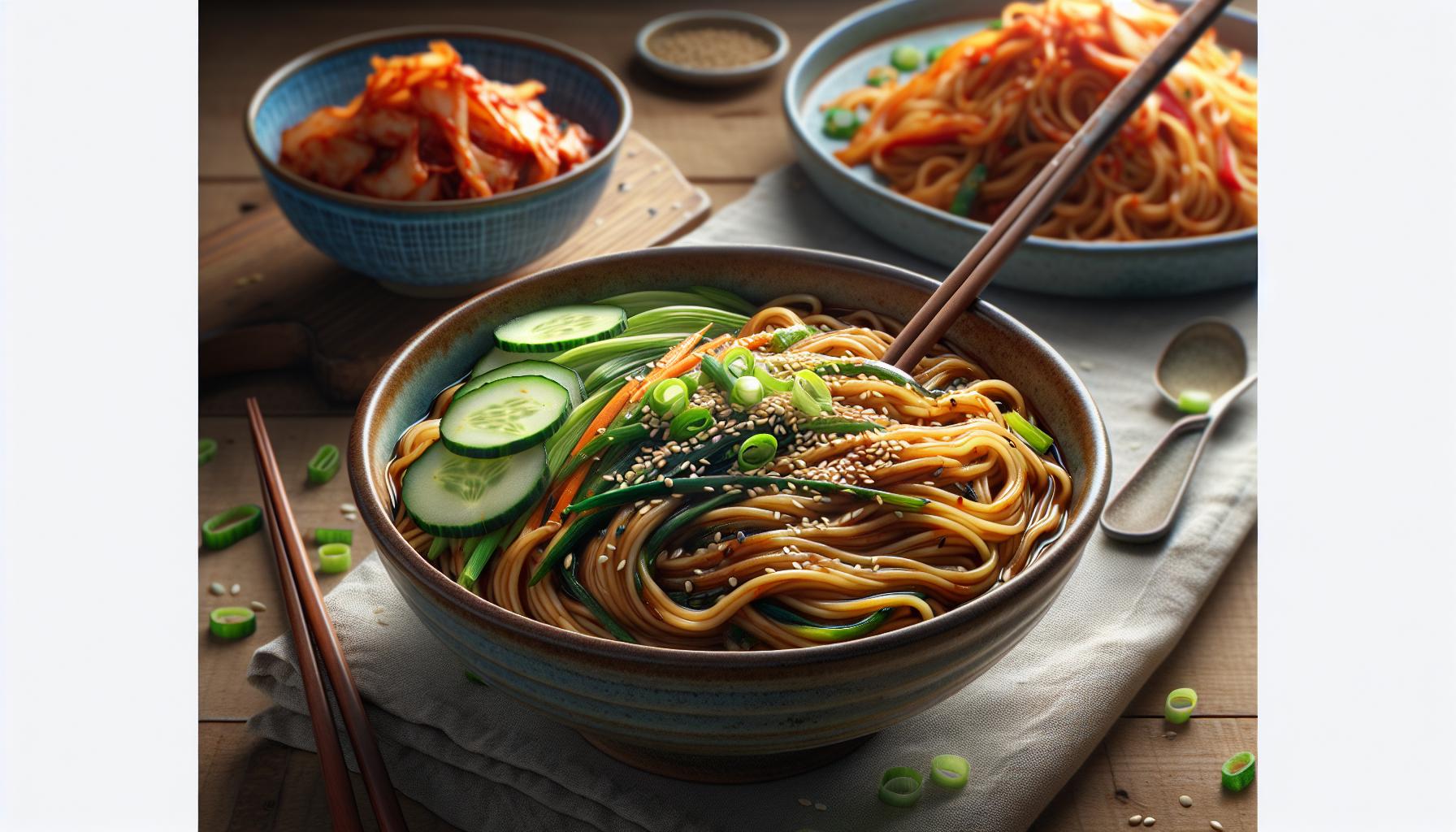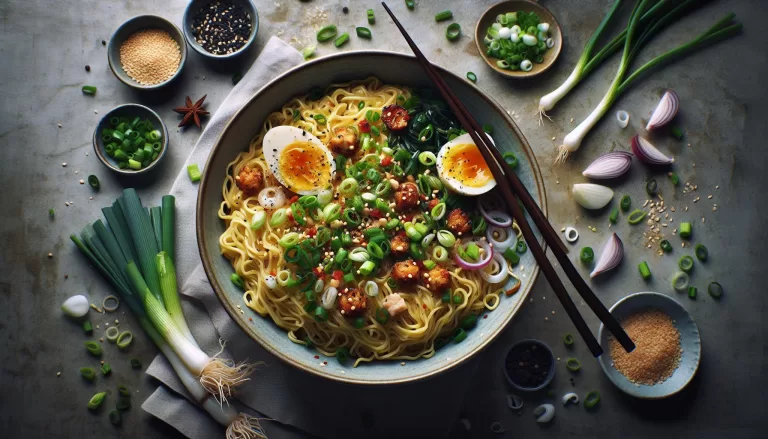Easy Authentic Homemade Beijing Zha Jiang Mian Recipe with Nutritional Guide

History of Zha Jiang Mian
Dive headfirst into the thrilling journey of Zha Jiang Mian – a culinary tale spanning across centuries. By learning its past, your appreciation for this classic dish will deepen.
Zha Jiang Mian’s lineage traces back to the Qing Dynasty, moulded through time with countless interpretations. Here’s a glance of its history:
Qing Dynasty Era
Originating in the 17th Century, this humble recipe has its roots in the bustling noodle shops of northern China. As one of the first dishes made using wheat noodles, it stands as a culinary testament to China’s innovation in the food world. Alternative noodles back then weren’t as common as they are today.
1960s Modernization
Zha Jiang Mian blossomed in the mid-20th century. A demand surged for faster, more efficient meals. The birth of “fast food” came to play and Zha Jiang Mian was no exception. The dish adapted to the pace of a rapidly growing China, becoming a signature in almost every take-out menu.
Today’s Zha Jiang Mian
Fast forward to modern times and the dish has taken many forms. The plain wheat noodles and fermented soybean paste, classic ingredients, are still there. However, personalized versions of the recipe now include seafood, different types of meat, and varying vegetables. Your kitchen opens up a world of savory opportunities with every bowl.
The evolution of Zha Jiang Mian embodies the unstoppable nature of food culture. Yet, the essence of this dish- a satisfying, hearty meal- has remained consistent through time. When you savor your homemade Zha Jiang Mian, let the rich history in every bite fuel the joy of cooking this Beijing delicacy.
With a recipe this deep-rooted, your kitchen becomes part of a historic culinary movement. Time to heat up your stove, choose your ingredients, and explore the tradition and innovative possibilities of Zha Jiang Mian.
Ingredients for Homemade Beijing Fried Sauce Noodles
Let’s dive into the ingredients that bring life to your Zha Jiang Mian. Remember, true Beijing flavor comes from carefully compiling key elements, but feel free to sprinkle in personal touches.
First off, noodles form the backbone of this recipe. Use 100 gm of Chinese wheat noodles per serving for an authentic experience. However, you can go for Italian spaghetti as a clever substitute without sacrificing the dish’s integrity.
Secondly, the “zha jiang” or the fried sauce asks for 300 gm of ground pork. Lean ground beef or turkey also works and adds a unique twist on the traditional version.
For the vegetable mix, you will need:
- 1 cucumber
- 2 spring onions
- 1 radish
These bring a refreshing crunch and balance to the hearty meat sauce. You can add colorful bell peppers or shredded carrots for that extra nutritional kick.
Our sauce’s superstar is the fermented soybean paste cake known as “Tian Mian Jiang”. It’s rich, salty, and packs a punch of umami. This might be hard to find locally, so Korean Doenjang or Japanese Miso are recommended replacements.
Rounding up the sauce ingredients are:
- 1 Tablespoon of sweet bean sauce
- 1 Tablespoon of yellow soybean paste
- 2 finely chopped garlic cloves
- 1/2 cup of chicken stock
These enhance the overall flavor profile of the sauce giving it that irresistible aroma and taste.
Now let’s break down the nutritional value of this hearty meal in a markdown table:
| Nutrient | Per Serving |
|---|---|
| Calories | 600kcal |
| Carbs | 56gm |
| Proteins | 25gm |
| Fats | 30gm |
Step-by-Step Cooking Instructions

When you’re ready to embark on this culinary journey, just follow these uncomplicated steps. Time to add that special touch to your kitchen!
Stage 1: Noodle Preparation
Start with the noodles. Boil your Chinese wheat noodles or Italian spaghetti according to the pack instructions. If you’re improvising with other noodle types, aim for an al dente finish. Drain well and set aside. Your noodle base is now ready for the exquisite Beijing flavors!
Stage 2: Creating the Fried Sauce
Next, let’s get that tantalizing sauce simmering. Heat some oil in your pan and toss in your choice of ground meat. Pork is traditional, but feel free to experiment. Don’t be shy with your Tian Mian Jiang—this is the magic ingredient that will give our dish its authentic Beijing touch.
Next, add in garlic, sweet bean sauce, yellow soybean paste, chicken stock for that added depth of flavor. Let it simmer till it blends into a luscious savory symphony.
Stage 3: Adding the Veggies Mix
For the grand finale, introduce your fresh veggie mix – cucumbers, spring onions, radishes. Keeping them raw preserves that refreshing crunch in contrast with your soft noodles and rich sauce.
Remember, it’s not just about following the basic steps, but about dialing up your own creativity in the kitchen. Your homemade Beijing fried sauce noodles can have your personal spin to it. Maybe add a side of Kimchi, or top with a sprinkle of Sesame seeds?
Let’s take a look at a brief nutritional spotlight of the dish per serving.
| Nutrient | Amount |
|---|---|
| Calories | 450 |
| Carbs | 70g |
| Proteins | 13g |
| Fats | 15g |
Tips for Perfecting Your Zha Jiang Mian

Mastering Zha Jiang Mian, like any other culinary endeavor, requires practice, precision, and the courage to experiment. Keep in mind these helpful tips to enhance your noodle dish and bring out the authentic Beijing flavors.
First off, the selection of Tian Mian Jiang. It’s your sauce’s backbone, and settling for any replacement could leave your taste buds wanting. Make sure it’s on your shopping list!
Then let’s talk about the balance of flavors. Zha Jiang Mian shines with its perfect harmony of sweet, salty, and umami. The secret?
- Swapping half the sweet bean sauce with yellow soybean paste. Though not traditional, it definitely gives your sauce an extra kick.
- Consider adding a touch of chicken stock. It’s a simple way to enhance the depth of your sauce.
Remember, when prepping your noodles, to aim for an al dente texture. Noodles that are too soft fail to hold the sauce properly, robbing you of the ultimate bite in each mouthful. Stay patient, check it at regular intervals, and trust your instincts.
When it comes to vegetables, go fresh. Fresh cucumbers, radishes, and spring onions lend crunch, freshness, and a pop of color to your Zha Jiang Mian. Don’t shy away from adding in your own mix of veggies you’ve got lying around — it’s all about making the dish your own!
For a unique twist, try serving your Zha Jiang Mian with Kimchi on the side. The spiciness and tanginess of the Kimchi robustly compliment the rich, savory noodle dish, creating a symphony of flavors.
Maintaining good health while indulging in your culinary adventures is also critical. So here’s a nutritional breakdown per serving:
| Nutrition | Amount |
|---|---|
| Calories | 660 |
| Carbs | 98g |
| Protein | 20g |
| Fat | 20g |
Enjoy the process of creating your homemade Zha Jiang Mian, and let your kitchen be your playground.
Serving and Enjoying Your Homemade Zha Jiang Mian

You’ve prepared your dish with care, focusing on balance and authenticity. Now, it’s time to enjoy the fruits of your labor. The way you serve Zha Jiang Mian can significantly elevate your dining experience.
Start by placing a generous amount of noodles in a bowl. Next, heap on your homemade sauce. Remember, it’s all about your taste. More sauce equals a stronger, robust flavor. Less sauce offers a subtler, more delicate taste. There’s no wrong way, simply your way.
Compile your colorful array of fresh vegetables on top. The brightness of your cucumber, radish, and spring onions not only adds to the aesthetics of the dish but also provides a delightful crunch. Don’t forget about personalizing your creation. Perhaps you’re a fan of something a little less traditional. Bok choy, bell peppers, or even some pickled ginger could be your unique addition, offering a surprise with every bite.
No Chinese noodle dish would be complete without a side of Kimchi. The tangy spice of Kimchi perfectly complements Zha Jiang Mian’s symphony of sweet, salty, and umami flavors. Not only does this serve up a delicious flavor contrast, but it also introduces the gut-healthy benefits of fermented foods.
As an extra optional step, garnish with a pinch of sesame seeds or a dash of chili oil. These small finishes can take your flavorful dish, making it an unforgettable experience.
Rest assured that Zha Jiang Mian is not only a pleasure to your palate, but also offers a balanced nutritional profile. With each bowl, you consume:
| Nutrient | Per serving |
|---|---|
| Calories | 530 kcal |
| Carbs | 79 g |
| Protein | 21 g |
| Fat | 15 g |
While preparing this dish involves diligence, enjoying it requires no effort. As you enjoy your homemade Zha Jiang Mian, remember that cooking is an art with room for improvisation. Every recipe leaves space for you to showcase creativity. True satisfaction comes when you transform this traditional recipe into your unique culinary masterpiece. Savour the process and keep experimenting with combinations that work for you.
Conclusion
So there you have it. You’re now equipped to whip up your very own Zha Jiang Mian at home. Remember, it’s all about personalizing your dish and getting creative with your ingredients. Don’t shy away from adding a bit of bok choy or a dash of pickled ginger. Looking for a flavor punch and a health boost? Toss in some Kimchi. And don’t forget those finishing touches like sesame seeds or chili oil. They’ll take your noodles from good to great. This isn’t just about following a recipe. It’s about making it your own, creating a balanced meal that’s as nutritious as it is delicious. So go ahead, get in the kitchen and start experimenting. Your culinary masterpiece awaits.





